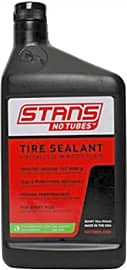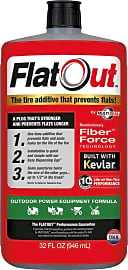The 10 Best Tire Sealants

This wiki has been updated 35 times since it was first published in January of 2017. Flat tires are a major pain, leaving you stranded on the side of the road and fumbling around with an old spare you thought you'd never have to use. They are just as much of a hassle for cyclists, bikers and ATV riders, too. With the right sealant, though, the experience can be made a little less painful. These can help you get on your way quickly or save you from a flat in the first place. When users buy our independently chosen editorial selections, we may earn commissions to help fund the Wiki.
Editor's Notes
November 27, 2020:
As one might expect, we don't see a lot of innovations in tire sealants from year to year. Once a company produces an effective formula, there really is little need to change it. Because of this, we stand by all of our previous recommendations. We feel there is a good variety of options here to suit nearly every need, whether you have an ATV, bicycle, motorcycle, or car or truck.
Speaking of the various transportation types, it is vital that you choose a tire sealant that is appropriate for your vehicle, otherwise you could be exposing yourself and passengers to a dangerous situation. For example, Fix-A-Flat can cause balance issues if used in tubed motorcycles tires, which will interfere with the ride and could potentially be the cause of a crash. So, if you are looking for something for you Harley or Triumph, you should turn to Ride-On Protection System instead.
The same goes for highway versus non-highway vehicles. Obviously, highway vehicles travel at much faster speeds, and some formulas are not intended for those kinds of situations. Take QuadBoss ATV and Multi Seal FlatOut, for example. Neither should be used on a vehicle traveling at highway speeds. In fact, Multi Seal FlatOut is only intended for slow-moving equipment like tractors and lawn mowers. Conversely, QuadBoss ATV can be used on quads and dirt bikes, but even then, it isn't recommended for extreme high-speed competitive applications.
Another thing to take note of is whether you want a preventative or after-the-fact solution. Preventative options, like Berryman Seal-R and Slime Prevent and Repair stay liquid within the tire. This way, when a puncture happens, they will immediately clog the hole and you probably won't even notice your tire encountered a problem. It is worth nothing that neither of these are intended for highway vehicles as a preventative, though. Other formulas, such as TireJect On-Road Bead Sealer and Fix-A-Flat, are intended to be used after you get a flat. Fix-A-Flat will even inflate your tire enough to get to a mechanic, so you don't have to worry about also keeping a tire inflator in your vehicle.
August 28, 2019:
Nearly every driver or bike rider has experienced a flat tire at some point in their life, so we all know what a headache it can be. Luckily, these tire sealants provide you with an easy way to get back on the road or trail, and sometimes even avoid getting a flat entirely. However, it is very important to understand that not all sealants are created equal. Some, like TireJect On-Road Bead Sealer, are designed for use on highway speed vehicles, while others, like Orange Endurance, are only suitable for use on bicycles. Then you have options like Berryman Seal-R, which can be used on practically any kind of vehicle and in any type of tire.
We have done our best to mention what mode of transportation each formula on our list is intended for, but we still recommend you double check that a particular option is suitable for your needs before purchasing. It is also important to read the directions before use, as some options, such as Slime Emergency Flat Repair and Fix-A-Flat are not intended to be permanent solutions, but rather to get you safely to a professional repair shop.
Tire sealers can be preventative or after-the-fact solutions depending on the product. Of the options on our list, TireJect On-Road Bead Sealer, Slime Emergency Flat Repair, and Fix-A-Flat are only designed for after-the-fact use. All of the rest of the items can be used to repair a flat after experiencing one, or as a prophylactic.
How Tire Sealants Work
Glycol-based formulas contain a number of additives, such as binding agents, organic thickeners, rubber particles, cellulose fibers, and mica.
Tire sealants are one of the simplest and most cost effective ways to fix or prevent flat tires. Most often, they are comprised of a base of either glycol or latex. Glycol-based formulas contain a number of additives, such as binding agents, organic thickeners, rubber particles, cellulose fibers, and mica. The glycol acts as a carrier liquid for the additives. The fibers and particles can be anything from wool or Kevlar to ceramic. Latex-based formulas require fewer additives to plug tires. Because of this, latex varieties have a lower production cost and are often found in less costly tire sealants. While latex-based options are effective initially, they do have a shorter life span and will often dry in the tire more quickly than glycol-based formulas.
Both types of tire sealant work in a similar manner. They remain in a liquid state when injected into the tire until a puncture occurs. At this time, the pressure inside of the tire combined with centrifugal force pushes some of the tire sealant out through the puncture. The particles and fibers in glycol-based formulas clog the hole, creating an air-tight patch. Latex-based formulas work slightly differently. As a latex-based formula gets pushed out through the puncture, the escaping air passing over it causing it to rapidly dry and solidify, practically becoming part of the tire.
Despite a common misconception, the majority of tire sealants are actually intended for use as a preventative measure before one ends up stuck on the side of the road with a flat. There are a select few, however, that are specifically designed for roadside emergencies. Fix a Flat is one such variety. You can quickly identify whether a particular tire sealant is intended for use as a preventive or after-the-fact repair solution based on whether or not it contains some form of compressed air. While preventative tire sealants are safe for use after one gets a flat tire, after-the-fact repair solutions should not be used as preventative measures.
Pros And Cons Of Tire Sealant
Tire sealant is an extremely fast and affordable solution to fixing or preventing a flat. There is no arguing that it is also very convenient. Rather than spending thirty minutes sweating on the roadside swapping out your tire for a spare, you simply pull a small can out of your trunk, attach it to your damaged tire's valve, and voila. No more flat tire. If you used the preventative variety, you may not ever even notice that your tire was punctured. It will simply repair itself as you continue to cruise down the highway.
Some service centers also refuse to fix a tire treated with a chemical sealant.
One can purchase tire sealants almost anywhere, from your local automotive parts store to that corner gas station you pass every day. The best place to buy it is often online, though, where one can compare the many different varieties available for price and quality before making their choice.
Using tire sealant is also an ingenious way to prolong the life of an older tire if one doesn't have the time or money to replace it. While we would never recommend someone drive on a tire that is worn, cracked, or otherwise compromised, if you are determined to do so, injecting a bit of tire sealant into it can make it significantly safer.
It is important to note that some tire sealants actually have the potential to damage a tire. If applied incorrectly, it can pool at the bottom, where it may dry and cause an imbalance or wheel misalignment. While rare, tire sealant may also damage the sensors inside of premium vehicles that alert the driver to when the pressure is low.
In some instances, low-quality sealants have been known to cause wheel corrosion, resulting in a costly replacement. Some service centers also refuse to fix a tire treated with a chemical sealant. There are a number of reasons for this, including the fact that some contain hazardous chemicals, and that they can increase the pressure inside of a tire to a point where the mechanic risks injury when trying to repair it. For most consumers though, the benefits and convenience of tire sealant far outweigh any potential drawbacks.
What Else To Keep In Your Roadside Emergency Bag
Tire sealant is just the one of many items that all drivers should keep in their car at all times. One of the smartest solutions is to purchase an emergency road kit that already contains any and everything you may need. For those that prefer to go the DIY route and piece together their kit, here are a few useful items you may want to consider purchasing.
Keeping a charged jump starter in your vehicle allows you to get your car started and back on the road without aid from anyone else.
Every car needs a fire extinguisher. It isn't often that automobiles catch fire, but when they do, if you don't have something to put it out quickly, you risk being in the vicinity of a nasty explosion. Keeping a fire extinguisher handy ensures you are ready to tackle the problem should it ever arise.
When stuck on the side of the road, it is important to alert other drivers of your situation. This may be because you are crouching next to the vehicle trying to repair the problem and you want to ensure passing motorists can see you for safety reasons, or you may need to attract the attention of emergency responders or a friendly driver who may be able to help. For these purposes, it is useful to have flares, triangular road reflectors, or flashing LEDs.
It seems like cars rarely break down on a nice sunny day. Rather, it often happens late at night, when it is so dark you can barely see your hand in front of your face. A flashlight will become invaluable at times like these.
Perhaps no items come in handier than a good pair jumper cables and a jump starter. Dead batteries are one of the most common problems to plague motorists. Keeping a charged jump starter in your vehicle allows you to get your car started and back on the road without aid from anyone else. One should still keep jumper cables in their car though for those times you reach for your jump starter only to realize that you forgot to charge it.















